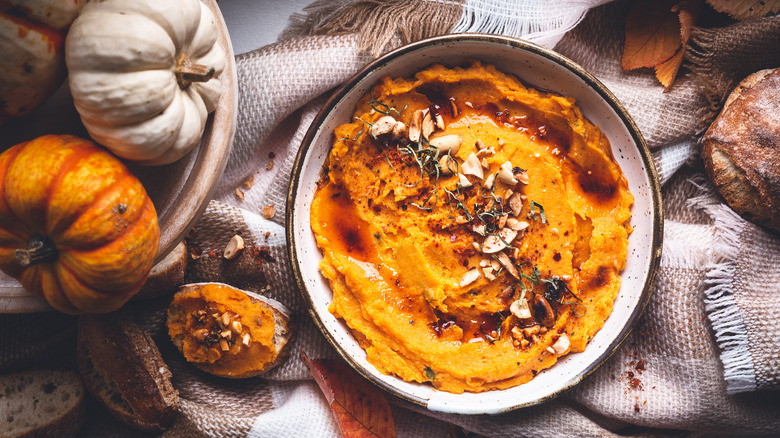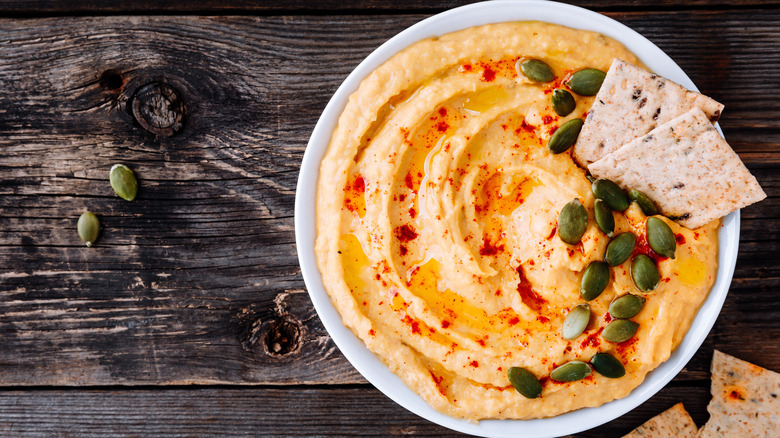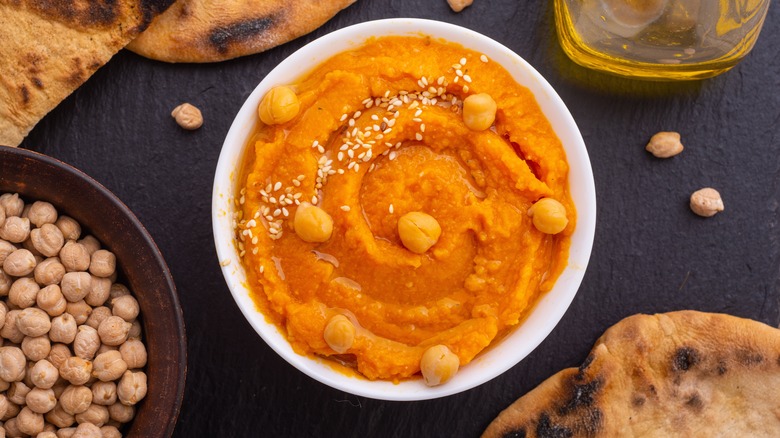Your New Favorite Hummus Is Made From Leftover Pumpkin Guts
Before leaves have even begun to fall, autumn's ubiquitous staple, the mighty pumpkin, seems to find its way into all sorts of sweet and savory food and drinks. From pies and soups chock-full of actual pumpkin to pumpkin-spiced beers and lattes, the orange gourd is pervasive for a few months out of the year. And yet, when it comes to carving jack-o'-lanterns, all of that pulpy goodness — otherwise known as the pumpkin guts — is often tossed away. This year, however, you may want to turn on the oven to roast more than just the seeds to whip up a different kind of snack.
If you're already a fan of both pumpkin and traditional hummus, a mashup of the two may just become your go-to fall dip or spread. You can serve it just like any other version of hummus, with pita or vegetables as dippers or on a sandwich or a wrap. And while hummus is already a nutritional powerhouse, packed with plant-based protein, fiber, and healthy fat, pumpkin is no slouch when it comes to nutrients either. A serving of pumpkin has more than twice the recommended daily amount of Vitamin A, and it has multiple antioxidants. Plus, it's 94% water, so it's hydrating, too.
What is pumpkin hummus made of and how do you make it?
The simplest version of pumpkin hummus combines the roasted flesh of a small pumpkin with traditional hummus ingredients: chickpeas, tahini, olive oil, garlic, and lemon juice. After roasting the pumpkin (and allowing it to cool to room temperature), simply place it in a food processor or high-speed blender with the other ingredients and blend until smooth. You can adjust the consistency by adding more or less olive oil.
Once you have your base, you can also change up the flavor profile. For a savory hummus, add spices like cayenne, cumin, paprika, or crushed red pepper. For a richer garlicky flavor, roast your garlic cloves before adding them to the mix. You can also add smokiness with a dash of smoked paprika. And don't sleep on incorporating fresh herbs like rosemary or parsley as mix-ins or garnishes.
If you're looking for a sweeter hummus, omit the garlic and blend in vanilla extract or sweeteners like honey or maple syrup. You can also add pomegranate seeds as a sweet garnish. Fragrant spices that evoke the warm aromas associated with autumn also work well, such as cinnamon, nutmeg, or — of course — pumpkin pie spice. For sweet hummus, try serving dippers like fresh apple or pear slices, graham crackers, or pretzels.
Tips for making the best hummus at home
One of the keys to making restaurant-quality hummus is to ensure that it turns out silky smooth. To avoid getting gritty hummus, use dried chickpeas instead of the canned variety. When cooking dried chickpeas, add a little bit of baking soda to the water. This will not only speed up the cooking process, but it will also help the beans to break down, making them easier to blend.
Another way to achieve smooth hummus is to add an ice cube or two when blending. The ice will help to introduce air into the mixture, creating the perfectly smooth texture you're looking for. Don't rush the process. Give the mixture plenty of time to come together to get the most luxuriously velvety results.
If you do choose to use canned chickpeas, you can add a bit of the liquid they are packed in (called aquafaba) to the chickpea mixture while blending. Aquafaba is an emulsifier, which means it helps to bind the ingredients together. This can help to create a smoother hummus. However, if you use aquafaba, you may need to reduce the amount of olive oil in your recipe.
Finally, using the best ingredients is the key to any recipe's success, and hummus is no exception. Using high-quality olive oil and fresh lemon juice will help you create the most flavorful hummus — along with that fresh pumpkin, of course.



